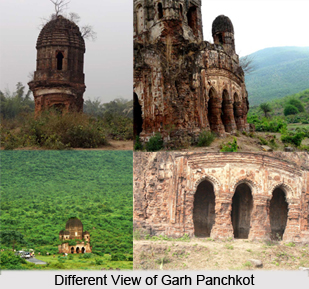 Garh Panchkot is situated in the eastern part of the country, at the foot hills of Panchkot in the district of Purulia, in the Indian state of West Bengal. The ruins of the Panchkot Palace are silent evidence to the Bargi attack during the 18th century. As the name suggests "Garh" means a fort in Sanskrit language.
Garh Panchkot is situated in the eastern part of the country, at the foot hills of Panchkot in the district of Purulia, in the Indian state of West Bengal. The ruins of the Panchkot Palace are silent evidence to the Bargi attack during the 18th century. As the name suggests "Garh" means a fort in Sanskrit language.
History of Garh Panchkot
From the view point of historical facts, Alivardi Khan had become the Nawab of Bengal in April 1740 having defeated and killed Sarfiraz Khan. Rustam Jung, Sarfiraz`s brother-in-law challenged Alivardi Khan but failed in his endeavours which prompted him to seek the help of the Maratha Rulers of Nagpur, Raghoji Bhonsle.
A cavalry of Maratha army was sent by Bhosle who entered Bengal through Panchet and started looting the countryside. These Maratha men were later came to be known as "Bargi`s". For about 10 years they looted and plundered Bengal. It ended in the year 1751 after a settlement was reached between the Nawab of Bengal and Maratha King. During one of these encounters Garh Panckot was attacked by the "Bargi" and having defeated the King`s guards they destroyed it after looting and plundering the palace. It is believed that all the 17 wives of the king committed suicide in a nearby well during the attack. Since then this place lies in ruins.
Description of the Palace
The construction of entrance to the palace, a semicircular moat, started from one end of the foothill to the other end. The only way to enter the place was by crossing the moat using a boat at the centre of the semicircle. The rest of the area was either inaccessible due to large growth of bamboo trees, a special type of bamboo trees which grew thick wild making it very difficult for intruders and a thick and high stonewall.
It did not end there; at 600 feet above in the middle of the Panchakot Hill were the guard`s quarters. It was in contrast to the architecture of the palace below, as it was completely made of huge stones slabs. From what is known it was built around 600 to 700 years back; how the blocks of stones were carried to this height is not known though one can only guess from the grooves left on the stones. A series of grooves were made mostly on the surface of the stone blocks, which ran right across from top to bottom. These could have been fastened to a leather belt and then using a coir rope pulled by the workers as that was one of the ways huge boulders were moved during those days.
What is fascinating is the strategic position of the guard`s quarter. Spread over a 500 square meters area is more of a miniature fort surrounded by solid rock walls with only one entry point, the pyramid like hollow gate from where the entire palace below and the surroundings could be watched.
Once inside the fort, on the right as well as left there are two long and narrow rooms with small vents overlooking the plains. In the centre stands a stone temple dedicated to Lord Rama the king of Ayodhya, this signifies that it was truly a guard`s quarter as more appropriately the people who guarded the area were the elite warriors and generally worshiped Lord Rama as he represented strength, courage and who had fought many wars. From the other remains one cannot ascertain the true nature of its usefulness; a hollow lions head made of stone known as the "Singh Mukh" or other artefacts mostly made of stone.
Temples of the Palace
The king was a Rajput chieftain who believed in Shaktism, although the Temples reflect his inclination towards Vaishavism. This could be due to the influence of Sri Chaitanya a proponent of Vaishavism, during that period. The two distinctive architectural styles, which are evident from the temples, are the Bishnupuri style and a much older architectural style of using stone blocks. It is believed that the Bishnupuri styled temples housed Lord Krishna and the followers were mostly vegetarians whereas the Stone Temples housed the figure of goddess Kali and the followers were non-vegetarians and also believed in animal sacrifice. This lends credence to the fact that the King was tolerant towards other beliefs as one more Jain cave can be found in the vicinity.
There is another very old stone temple, which is dedicated to Lord Rama. This could be because it is believed that most of the Hindu Kings of India were Raghu-Vanshis or descendants of Lord Rama the mythical and legendary king as per the Hindu epic Ramayana. 600 ft above sea level in the middle of Panchakot hill the guard`s quarter stands as a formidable fort.
Arms and Ammunition
During those days in India, warfare was mainly fought with bows and arrows, spear, swords, daggers, cannons, etc. It was sheer strategy and numbers that mattered, not the arms. In a phased-out manner it started with sword fights.
Army



















